
| YRBM 16 and Cambodia |
| Barge Support Base |
| Chau Doc, Bassac River |
|
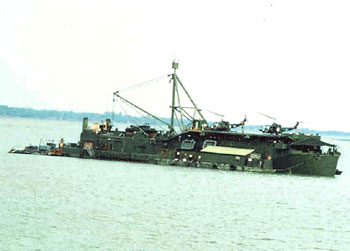 |
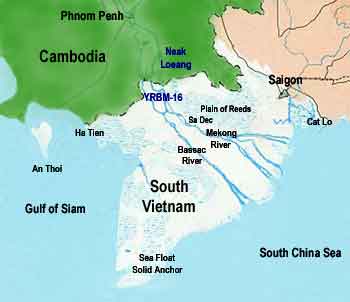 |
With the build up of the brown water naval forces of
Operation Game Warden (TF116)
and the
Mobile Riverine Assault Force (TF117), the need to provide rapidly re-deployed
support services for these operations was quickly recognized.
The answer was to convert existing non-propelled harbor "Large Covered Lighters" (YFNs and YFNBs) into multiple purpose
"Repair, Berthing, and Messing Barges" (YRBMs). The first of these conversions took place in Sasebo Japan during early 1967. The
261 foot Lighter YFNB-21 was converted to YRBM-16, including all of the repair shops, berthing and messing facilities
needed to provide support for river operations in III Corps area of Vietnam.
|
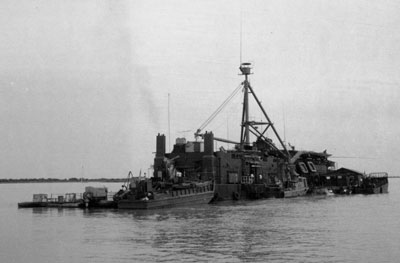 |
This important asset was towed to country and placed in locations on the Bassac River in areas around Can Tho. It served its
function well until Thanksgiving night 1967, when it was severely damaged by a remotely detonated bomb while anchored near Ben Tre.
The barge was towed back to Sasebo for repairs and soon returned to service on the Bassac and Mekong Rivers. By 1970, YRBM-16 had
found a home at Chau Doc on the Bassac close to the Cambodian border.
|
YRBM-16 was followed during the next year and a half with five additional YRBMs: these were YRBM Numbers 17 thru 21. The YRBMs perfomed a vital service function throughout the conflict. Some were eventually turned over to the VNN, along with other US Naval resources, as part of the Vietnamization Program. Although available for use as instant permanent bases, most were on the move constantly as new operations were initiated, or in a random fashion as a security measure to prevent their being the target of sapper attacks. | 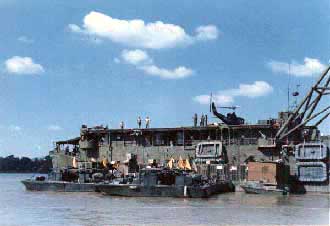 |
 |
Many soldiers and sailors remember well and fondly these safe havens where their craft could be serviced, their bodies rested and the opportunity provided to partake of a rare hot meal. As SEALORDS gathered steam in the mid part of 1969 and into 1970, the Swifts joined other river patrol forces to take part in the push to take the interdiction operations closer to the border of Cambodia. The YRBMs then served as "forward bases" for the PCFs operating out Cat Lo and eventually, in mid 1970, out of Sa Dec |
Some of the longest patrols conducted by the Swifts were from the YRBMs. It was not unusual, as the interdiction effort moved right up to the borders on the Mekong, Bassac, and Vinh Te riverways, for a PCF to travel from the support barge to a position very close to Cambodia and then lay in wait in an ambush posture for five or more days before returning to the "mother barge" for a respite. |
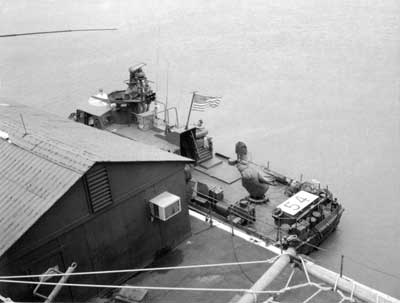 |
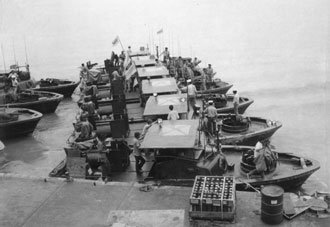 |
|
| Bill Roger's PCF-54 at the "Beer Barge" after a long patrol | VNN PBRs return from patrol and prepare for inspection |
One major advantage of having the YRBMs close to the patrol and interdiction activities of the "brown water" craft was the ability of the helicopter gunships (Seawolves) to be quickly reloaded by the YRBM service personnel for a rapid return to the scene of action as needed. The crew members became very proficient at this vital evolution - which was known as a "Hot Turn Around." Current NASCAR pit crews could learn a thing or two from these dedicated sailors. |
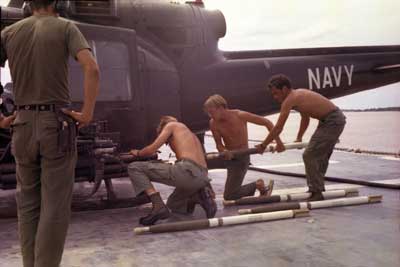 |
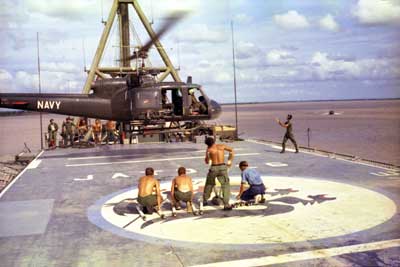 |
Just as important, if not more so, as having airborne gun platforms close by during patrol activity, was the availability of the YRBM helicopter pad for medical evacuation "Dust Off" flights of wounded personnel. Knowing that minutes could mean the difference between serious permanent injury and a full recovery, having a heli-pad in close proximity was a comforting morale booster. |
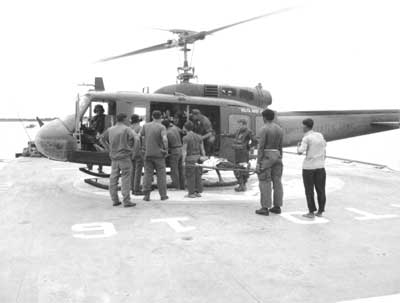 |
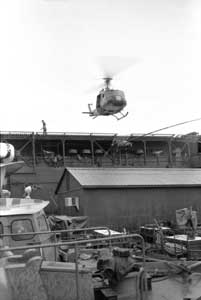 |
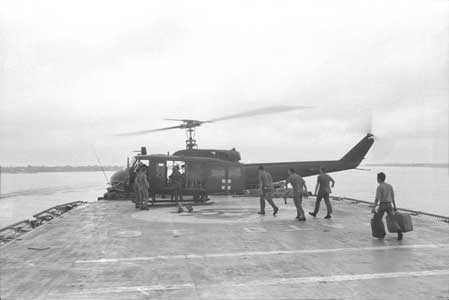 |
YRBM-16 became very important to the Swifts assigned there in May 1970 as the staging base for the historic incursion into Cambodia in support of Operation Tran Hung Dao XI. |
|
On April 29 1970, President Nixon authorized a major operation to cross over into the Cambodian "sanctuaries" and engage any northern forces encountered that were utilizing these areas as staging areas for infiltration of personnel, supplies, weapons, and other operations into the central part of South Vietnam not far from the capital Saigon. |
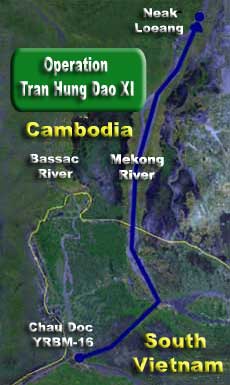 |
The US and South Vietnamese Navies took part in this incursion under the auspices of Operation Tran Hung Dao XI. The primary
mission of this sub-operation was to clear the Cambodian side of the Mekong River of NVA supply activities, to cut the major
land route from Phnom Penh at Neak Loeang by capturing the only ferry boat present at that location, and to repatriate South Vietnamese
refugees that were being detained in the areas in and around the Cambodian capital.
This would be accomplished by a significant river borne force moving up the Mekong as far as Neak Loeang and off loading supplies and
additional land forces to supplement the airborne units dropped to engage any enemy forces encountered. The Americans were ordered not to
proceed any further than the ferry crossing. But South Vietnamese forces would proceed on up the Mekong as far as Phnom Penh to rescue
any South Vietnamese refugees they could find and transport them back across the border.
|
Swift Boats were part of this effort, being staged at YRBM-16, which at the time was located on the Bassac River in close proximity
of access to the Mekong border crossing area. The PCFs would lead the incursion across the border and dash up to Neak Loeang to provide
support for airborne troops landing there and act as a covering force for follow up support ships.
Bill Rogers penned the following note to his wife on the evening of May 8 as he was preparing to take his Swift Boat on the next day's
operation:
|
"It is late at night and I only have time for a short note. I am at Chau Doc on the YRBM-16. We just got in from an eight day patrol this evening. The big news is that tomorrow at 5:00 AM we are going north deep into Cambodia." |
 |
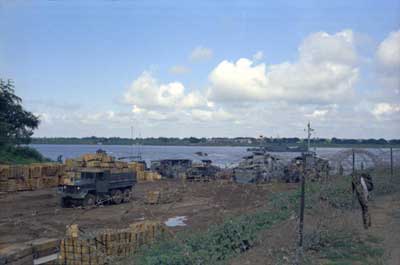 |
In a letter written just two days later, Bill describes the beginning of the Tran Hung Dao XI operation on May 9: |
"The assault went off perfectly yesterday. At daylight eight US Swifts crossed the border followed by thirteen VNN Swifts. We reached the ferry crossing we were after in about an hour and a half. The airborne troops landed just as we got there and the whole prize was taken very quickly. There were no casualties at all on the Swifts. Well over 100 boats and ships of all sizes came across after us, and they were all carrying several types of supplies for various operations" |
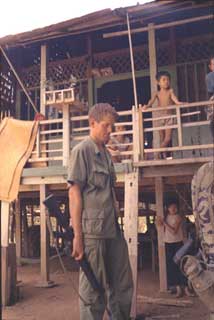 |
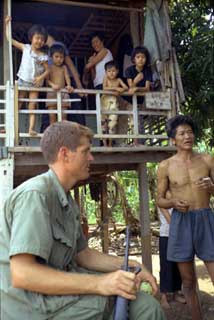 |
But the one fly in the ointment was that the ferry boat, which was a major objective of the operation, was no where to be found.
Bill was tasked with going ashore with US Navy and Marine Intelligence personnel to question local town's people about the location of
this transport vehicle which was vital to the movement of men and material by the north from the Phnom Penh area down into the
"Parrot's Beak" region southwest of Tay Ninh. They were told that the communists had scuttled the ferry in the middle of the
Mekong with the idea that it would remain hidden and could be later refloated for continued use after the allied forces left.
Based upon the information about the ferry from the locals, numerous reconaissance flights were conducted over the next few days
looking for the sunken vessel.
|
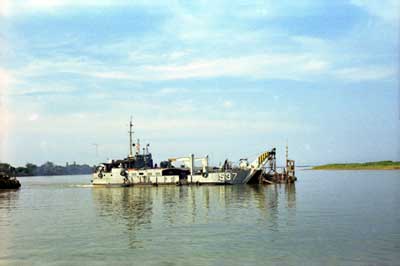 |
As luck would have it, the Deputy Commander of Naval Forces Vietnam, Admiral Mathews, spotted the underwater vessel while on an air inspection tour on May
12. That's what you get paid the big bucks for ... SIR!!
Salvage vessels and resources were brought up river from South Vietnam, and the ferry was subsequently raised and transported
across the border in order to deny its future use as an aid to infiltration.
|
|
Meanwhile, the South Vietnamese Naval and Land forces had proceeded on up the Mekong almost into Phenom Penh, clearing the area of any North Vietnamese military personnel, weapons and supplies. Having accomplished this mission, they gathered up as many Vietnamese refugees as could be found and began returning down river with the LSTs loaded with their happy human cargo. | 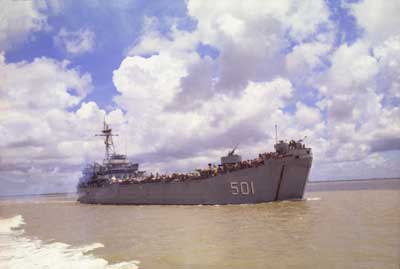 |
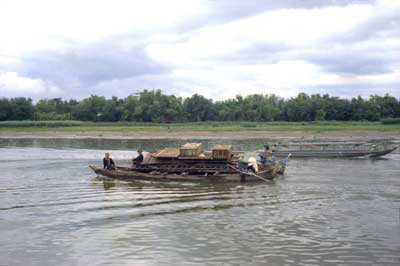 |
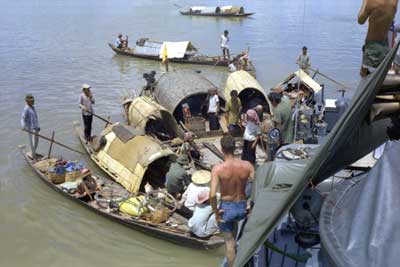 |
During the following days of the operation, the Swifts got on with the task that they always do best: searching the many water craft plying the river for contraband or "bad guys" and interfacing with the natives to "win the hearts and minds of the people." |
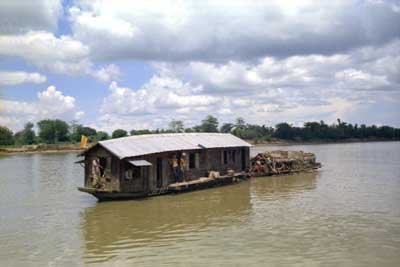 |
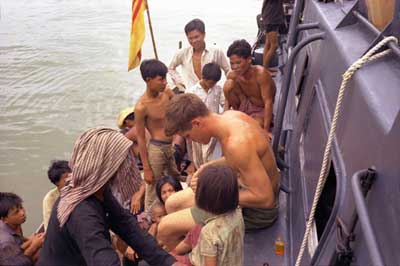 |
Based on the number of South Vietnamese flags being flown by the vessels operating in the Cambodia waters, you would have to believe that the population was receptive to having their hearts and minds won. |
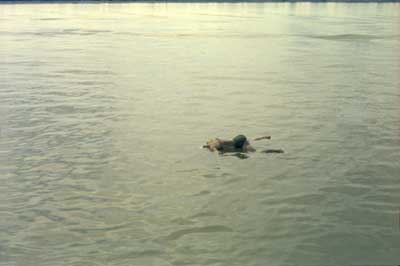 |
Unfortunately, there were a few civilians for which winning or losing hearts did not have much meaning. The refugee on the left, either South Vietnamese or Cambodian, paid dearly with his life for not conforming with the way that Uncle Ho Chi Minh desired for him to comport himself. |
The fellow on the right was an American freelance journalist and photographer that had caught a ride into Cambodia on a US Swift Boat. He asked to be dropped off on the shore to proceed on his own. It is hoped that he found what he was looking for and survived to tell about it. | 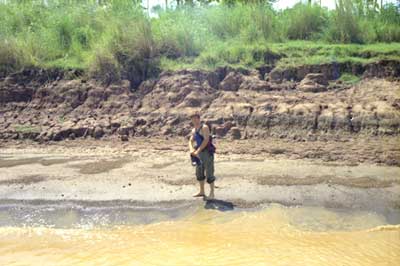 |
The incursion into Cambodia had to be considered very much a stunning military success. Significant formations of North Vietnamese Army
units were encountered, engaged and defeated. Great quantities of arms, ammunition, and other supplies were captured. And the operation
did have a significant effect, for a time, on the infiltration activities of the NVA into South Vietnam. However, public sentiment in
the United States resulted in political pressure for the military to conclude the operation. All activity was stopped and the allied
forces were withdrawn back across the border into South Vietnam on June 30, 1970.
To this this day, there is an ongoing debate among Swift Boat Sailors as to who was on the fantail of the last boat to sail back across
the border and therefore the Swifty that "turned the light out at the end of the tunnel"
|
This web site is Copyright � 2002 by Robert B. Shirley. All rights reserved. Click on image to return to the homepage
|